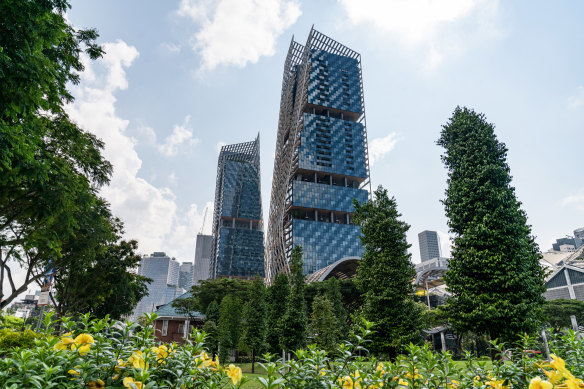
Save articles for later
Add articles to your saved list and come back to them any time.
The ugly, browning towers of Sydney and Melbourne are totems of the 20th century’s twin building mistakes. Here and in cities around the developed world, the slumming concrete of “affordable” high-rise is flattered only by contrast with the ideological eyesores created by utopian architecture.
The late Harry Seidler is one of many architects who have graffitied our harbour city with their concrete tags, while there’s a Jerry Springer episode in the paternity of Melbourne’s malaise. Given so much ugliness, it’s easy to sympathise with the anti-development set. Nobody wants this misery looming over their backyard.
Australian cities should embrace Singapore’s approach. Credit: iStock
But now the not-in-my-backyard – NIMBY – sentiment has brought us to an impasse. Our global cities appear doomed to remain forever global suburbs. We need more affordable inner-city housing, but it seems we cannot bear to build upward any more. Instead, we perpetrate McMansions and McMidrise in infrastructure deserts.
In a recent capitulation to inner-city NIMBYism, NSW Premier Chris Minns granted the City of Sydney, the council which governs the most attractive and well-served parts of inner-urban Sydney, an exemption from his government’s housing density targets. If any Australian city is positioned to become as vibrant as New York, as creative as Barcelona, or as commercial as Singapore, it is Sydney. But this puts paid to that.
I confess, I’m a YIMBY – yes in my backyard. I would like to see my home city grow into its global potential. And, as I write this from a Singaporean roof garden, I believe that the NIMBYs can be won over. But only if we properly understand what drives them.
There are two types of NIMBY. There’s the type we generally think of, when wielding the term pejoratively, who just want to be left in peace in their bucolic bungalow monopolies on inner-urban land. And then there’s another set, who are rarely identified as NIMBYs; they themselves would claim not to be.
But they very effectively block residential developments by demanding impossible trifectas of quality, affordable housing, and attractive design. As usual with these impossible triangles, the truth is you can only have two out of three.
Quality, affordable housing is often ugly. Affordable and attractive housing is usually low-quality. Quality and attractive design come at a cost. Often as not, when these social-justice NIMBYs demand the trifecta, we get none of the three. No development, no density, no dwellings.
Singapore is far from a perfect city, but there is an insight behind its graceful and innovative developments. The trading hub makes basic but functional public housing available to its residents. These apartments are not in the best part of town, but they are built for humans and, while they’re not all glinting facade and facility, they’re perfectly acceptable.
Meanwhile, developers vie with each other to “in-fill” the most attractive parts of the CBD with status condominiums for wealthier buyers. When those buyers upgrade, the apartments they leave become available to others on a lower budget, and so on down the chain. More affordable housing becomes available when less affordable housing is built. There is an incentive to construct the most extravagantly desirable new buildings in premium locations, creating a new and enviable skyline that vies with the world’s great cities.
Sydney and Melbourne could do this too. But it would require a mental shift: instead of thinking of building affordable housing as a service to humanity, the service is allowing the building of high-end dwellings that lure flashy rich people into parting with more of their money. By a process economists and urban planners call “filtering”, this makes less expensive and still-nice apartments available to others.
I can already hear the quills sharpening and the keyboards banging – incoming letters and comments from readers frustrated about “trickle-down economics reinvented”. Blame the experts, not me. Having lived in some of Sydney’s affordable spraycrete myself, I’d say, given a choice between trickle-down and rising damp, most of us would choose the former. Requiring developers to include “affordable” housing in their developments has lumped us mostly with the latter.
If social-justice NIMBYs can manage to shift their mentality, the bucolic bungalow types will become much more tractable too. First, the value of the land on which their family homes sit will shoot up – and almost everyone has their price, even the most change-resistant NIMBY. Second, the status value of bungalows will be seriously challenged by new and beautiful homes in the sky. If there’s one thing that can tempt a NIMBY, it’s a better backyard.
The South Beach complex in Singapore.Credit: Bloomberg
Maybe one day we can rid ourselves of some of the uglier mistakes. The poor hamsters living in glass-fronted, balcony-less Harry Seidler cages would no longer have to live like prisoners to find the best views in Sydney. One day, his monstrosities will finally meet an appropriately brutal bulldozing. They will be replaced by exciting designs. It’s worth aspiring to afford and create a skyline for all of us to gaze on.
Australia’s cities may not be the backyards all of us want to spend time in, but they are our front yard to the world. It’s time to start landscaping as if our global neighbours are looking. Eventually, the most fabulous of their citizens might even want to come in.
Parnell Palme McGuinness is managing director strategy and policy at award-winning campaigns firm Agenda C. She has done work for the Liberal Party and the German Greens.
The Opinion newsletter is a weekly wrap of views that will challenge, champion and inform your own. Sign up here.
Most Viewed in National
From our partners
Source: Read Full Article

